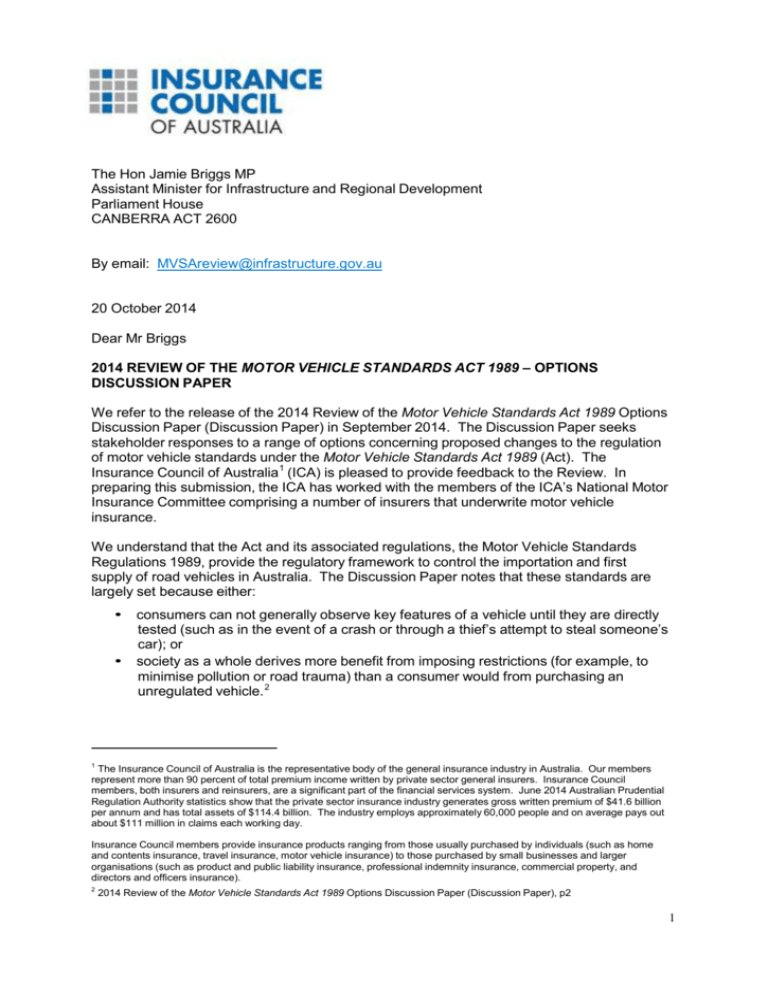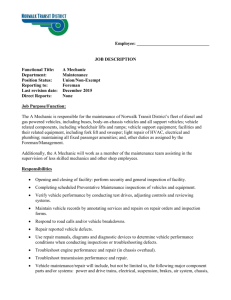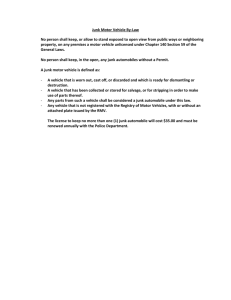advertisement

The Hon Jamie Briggs MP Assistant Minister for Infrastructure and Regional Development Parliament House CANBERRA ACT 2600 By email: MVSAreview@infrastructure.gov.au 20 October 2014 Dear Mr Briggs 2014 REVIEW OF THE MOTOR VEHICLE STANDARDS ACT 1989 – OPTIONS DISCUSSION PAPER We refer to the release of the 2014 Review of the Motor Vehicle Standards Act 1989 Options Discussion Paper (Discussion Paper) in September 2014. The Discussion Paper seeks stakeholder responses to a range of options concerning proposed changes to the regulation of motor vehicle standards under the Motor Vehicle Standards Act 1989 (Act). The Insurance Council of Australia 1 (ICA) is pleased to provide feedback to the Review. In preparing this submission, the ICA has worked with the members of the ICA’s National Motor Insurance Committee comprising a number of insurers that underwrite motor vehicle insurance. We understand that the Act and its associated regulations, the Motor Vehicle Standards Regulations 1989, provide the regulatory framework to control the importation and first supply of road vehicles in Australia. The Discussion Paper notes that these standards are largely set because either: • consumers can not generally observe key features of a vehicle until they are directly • tested (such as in the event of a crash or through a thief’s attempt to steal someone’s car); or society as a whole derives more benefit from imposing restrictions (for example, to minimise pollution or road trauma) than a consumer would from purchasing an unregulated vehicle. 2 1 The Insurance Council of Australia is the representative body of the general insurance industry in Australia. Our members represent more than 90 percent of total premium income written by private sector general insurers. Insurance Council members, both insurers and reinsurers, are a significant part of the financial services system. June 2014 Australian Prudential Regulation Authority statistics show that the private sector insurance industry generates gross written premium of $41.6 billion per annum and has total assets of $114.4 billion. The industry employs approximately 60,000 people and on average pays out about $111 million in claims each working day. Insurance Council members provide insurance products ranging from those usually purchased by individuals (such as home and contents insurance, travel insurance, motor vehicle insurance) to those purchased by small businesses and larger organisations (such as product and public liability insurance, professional indemnity insurance, commercial property, and directors and officers insurance). 2 2014 Review of the Motor Vehicle Standards Act 1989 Options Discussion Paper (Discussion Paper), p2 1 The ICA supports initiatives which will enhance the effectiveness of the motor vehicle smash repair industry in Australia and benefit the consumer. You have sought feedback in question 7-22 on the potential impact on the insurance industry from an increase in second hand imports and personally imported new cars as discussed in Option 7. 3 As some of our ICA members may provide individual submissions directly to the Review, the ICA will comment broadly on some of the considerations which may arise from this option. These factors stem from issues affecting an insurer’s decision to underwrite a risk and the basis of assessment of repairs once a claim is made. We will also discuss some of the regulatory factors which should be considered as part of any implementation of this option. Underwriting Considerations The ICA anticipates that it may be difficult for the insurance industry to accurately predict the impact of an increased level of imports envisaged in Option 7 in the absence of a range of available information such as: • • • the type, origin and age of the vehicle; whether it can be established that particular vehicles had previously been repaired; and the known general level of safety of the type of vehicle. As this information may not be readily available, it will be difficult for an insurer to assess the risk. Assessment of Repairs and Vehicle Safety The ICA submits that there should be a requirement for manufacturers to provide repair information as part of the importation process (for both new and used cars). We have previously contributed to the 2011-2012 Commonwealth Consumer Affairs Advisory Council (CCAAC) review into the sharing of repair information in the automotive industry where we emphasised the importance of access to technical repair specifications. Following this review the Federal Chamber of Automotive Industries (FCAI) has released a Voluntary Code relating to access to service and repair information. 4 Insurance companies in Australia authorise approximately 2.5 million repairs annually. 5 Further, repair costs make up 40-45% of the insurance premium cost. 6 As such, the ability to properly estimate and assess the level of likely repair costs for a class of vehicle is an important factor in establishing the maximum and average loss from year to year. As affordability is also a significant factor in the insurability of a certain class of vehicle, the availability of technical repair information from the manufacturer is crucial when undertaking vehicle repairs. 3 4 Option 7 is discussed in detail in the Discussion Paper, pp41-46 Available at http://www.fcai.com.au/library/publication/FCAI%20Voluntary%20Code%20of%20Practice%20on%20Acces s%20to%20Service%20&%20Repair%20Informatio....pdf 5 Motor Vehicle Insurance and Repair Industry Code Administration Committee Annual Report, March 2012 Deloitte Access Economics NSW Smash Repair Review Report, February 2014 prepared for the ICA as part of its submission to the NSW Select Committee Review of the Motor Vehicle Repair Industry, p43 6 2 Insurers have a responsibility to ensure repair costs are carefully managed in the interest of their customers and shareholders. At the same time they must ensure customers’ expectations are met in terms of safety and quality of repairs. Where an imported vehicle has no local dealer/manufacturer presence or support, vehicles requiring parts for a repair may be off the road for an extended period of time. A customer who may be expecting a quick repair to their car may be caught out by extensive delays. At a practical level, second hand vehicles may be imported into Australia after they have been involved in an accident. The lack of readily available information regarding the imported vehicle’s history may expose consumers to purchasing a vehicle that may have been involved in a collision and is structurally unsafe. We submit that an extensive safety regime would be needed to audit such vehicles to ensure previous repairs conducted in another market were conducted to a quality standard. Our members have also experienced problems completing repairs where the standards for Vehicle Identification Numbers (VIN) between different countries are inconsistent. They have experienced situations where the VIN does not appear to match the applicable standard, or a different version of the standard has apparently been applied. This can also lead to problems identifying, insuring and repairing these vehicles. Further we submit that appropriate regulations be put in place to ensure that any new or second hand cars pass appropriately rigorous safety checks before they are accepted into the market in Australia. We therefore support suggestions to expand the role of external inspectors discussed in the Discussion Paper. 7 Regulatory Impacts We believe that the current roadworthy requirements in each State may not be adequate if the volume of imported second hand and new vehicles increases. As such Federal regulation would be required to ensure that second hand vehicle imports and personal imports of new vehicles are appropriately identified. We submit that this may be implemented using existing mechanisms including the National Exchange of Vehicle and Driver Information System (NEVDIS) 8 and the Personal Property Securities Register (PPSR). 9 The NEVDIS database includes the VIN database and the Written Off Vehicle Register (WOVR) database. The ICA submits that enhancing these databases would assist insurers to properly price the risk involved in insuring such vehicles. The ICA also believes that consideration should be given to an education campaign to support any change so those who purchase an imported vehicle understand all the implications including the potential for delays if a repair is needed. 7 Discussion Paper, p34 8 Further details are available on the NEVDIS website - http://www.austroads.com.au/drivers-vehicles/nevdis 9 Further details are available on the PPSR website - http://www.ppsr.gov.au/Pages/ppsr.aspx 3 Conclusion Although the proposals in Option 7 may have a considerable impact on the insurance industry, the uncertainties involved make this impact difficult to quantify. We look forward to working with the Department of Infrastructure and Regional Development as it considers the various options for review of the Motor Vehicle Standards Act 1989. If you have any questions or comments in relation to the above please do not hesitate to contact Vicki Mullen General Manager Consumer Relations and Market Development on (02) 9253 5120 or vmullen@insurancecouncil.com.au. Yours sincerely Karl Sullivan Acting CEO 4







